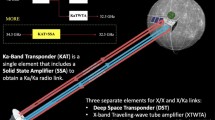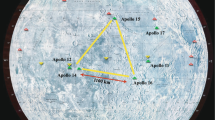Abstract
GETEMME (Gravity, Einstein’s Theory, and Exploration of the Martian Moons’ Environment), a mission which is being proposed in ESA’s Cosmic Vision program, shall be launched for Mars on a Soyuz Fregat in 2020. The spacecraft will initially rendezvous with Phobos and Deimos in order to carry out a comprehensive mapping and characterization of the two satellites and to deploy passive Laser retro-reflectors on their surfaces. In the second stage of the mission, the spacecraft will be transferred into a lower 1500-km Mars orbit, to carry out routine Laser range measurements to the reflectors on Phobos and Deimos. Also, asynchronous two-way Laser ranging measurements between the spacecraft and stations of the ILRS (International Laser Ranging Service) on Earth are foreseen. An onboard accelerometer will ensure a high accuracy for the spacecraft orbit determination. The inversion of all range and accelerometer data will allow us to determine or improve dramatically on a host of dynamic parameters of the Martian satellite system. From the complex motion and rotation of Phobos and Deimos we will obtain clues on internal structures and the origins of the satellites. Also, crucial data on the time-varying gravity field of Mars related to climate variation and internal structure will be obtained. Ranging measurements will also be essential to improve on several parameters in fundamental physics, such as the Post-Newtonian parameter β as well as time-rate changes of the gravitational constant and the Lense-Thirring effect. Measurements by GETEMME will firmly embed Mars and its satellites into the Solar System reference frame.












Similar content being viewed by others
References
Andert, T.P., et al.: Precise mass determination and the nature of Phobos. Geophys. Res. Lett. 37, L09202 (2010). doi:10.1029/2009GL041829
Andert, T.P., Rosenblatt, P., Pätzold, M., Häusler, B. Tyler, G.L.: The internal structure of Phobos and hints to its origin derived from Mars Express Radio Science observations, EPSDPS Joint Meeting p. 210 (2011)
Avanesov, G.: Results of TV imaging Phobos—experiment VSK-Fregat. Planet. Space Sci. 39, 281–295 (1991)
Barucci, M.A., et al.: NEO sample return mission. In: European Planetary Science Congress 2006, Berlin, Germany, 18–22 September 2006, p. 220
Bell, J.F., et al.: Solar eclipses of Phobos and Deimos observed from the surface of Mars. Nature 436, 55–57 (2005). s.l.: doi:10.1038/nature03437
Bibring J.-P., et al.: The Rosetta Lander (Philae) investigations. Space Sci. Rev. 128, 205–220 (2007)
Ciufolini, I., Pavlis, E.C.: A confirmation of the general relativistic prediction of the Lense–Thirring effect. Nature 431, 958–960 (2004). doi:10.1038/nature03007
Ciufolini, I., et al.: The LARES Space Experiment: LARES Orbit, Error Analysis and Satellite Structure. General Relativity and John Archibald Wheeler (2010)
Clark, B.E., et al.: Asteroid Space Weathering and Regolith Evolution. Asteroids III. s.l.: The University of Arizona Press (2002)
Craddock, R.A.: Are Phobos and Deimos the result of a giant impact? Icarus 211, 1150–1161 (2011)
Dickey, J.O., et al.: Lunar laser ranging: a continuing legacy of the Apollo Program. Science 265, 482–490 (1994)
Duev D.A., et al.: Spacecraft VLBI and Doppler tracking: algorithms and implementation. AA 541, A43 (2012)
Efroimsky, M., Lainey, V.: Physics of bodily tides in terrestrial planets and the appropriate scales of dynamical evolution. J. Geophys. Res. 112(s.l.: Issue E12) (2007)
Fienga, A., et al.: Planetary and lunar ephemerides INPOP10a. In: Journées Systèmes de Référence 2010, 20–22th September 2010, Paris
Galeev, A.A., et al.: The INTERBALL Project to study solar-terrestrial physics. Cosmic Res. 34(4), 313 (1996)
Giuranna,M., Roush, T.L., Duxbury, T., Hogan, R.C., Carli, C., Geminale, A., Formisano, V.: Compositional interpretation of PFS/MEx and TES/MGS thermal infrared spectra of Phobos. Planet. Space Sci. 59, 1308–1325 (2011)
Gondet, B., et al.: Phobos observations by OMEGA/Mars Express hyperspectral imager. EPSC Abstracts, vol. 5. s.l.: EPSC2010–548, European Planetary Science Congress (2010)
Hamilton, D.P.: The asymmetric time-variable rings of Mars. Icarus 119, 153–172 (1996)
Huygens VLBI tracking experiment 2008. JIVE Res. Note 0011
Jacobson, R.A.: The orbits and masses of the Martian satellites and the libration of Phobos. Astron. J. 139, 668–679 (2010). doi:10.1088/0004-6256/139/2/668
Jaekel, M.-T., Reynaud, S: Radar ranging and Doppler tracking in post-Einsteinian metric theories of gravity. Classical and Quantum Gravity 23(24), 7561–7579 (2006). doi:10.1088/0264-9381/23/24/025
Kawaguchi, J., et al.: Hayabusa-2. Its technology and science accomplishment summary. Acta Astron. 62, 639–647 (2008)
King, J.H.: A survey of long-term interplanetary magnetic field variations. JGR 81, 653 (1976)
Konopliv, A.S., et al.: A global solution for the Mars static and seasonal gravity, Mars orientation, Phobos and Deimos masses, and Mars ephemeris. Icarus 182(1) (2006)
Lainey, V., et al.: First numerical ephemerides of the Martian moons. Astron. Astrophys. 465, 1075 (2007)
Lynch, D.K., et al.: Infrared spectra of Deimos (1–13 \(\upmu \)m) and Phobos (3–13 \(\upmu \)m). Astron. J. 134, 1459 (2007)
Määttänen, A., et al.: Mapping the mesospheric CO2 clouds on Mars: MEx/OMEGA and MEx/HRSC observations and challenges for atmospheric models. Icarus 209, 452–469 (2010). doi:10.1016/j.icarus.2010.05.017
Marov, M.Ya., et al.: Phobos-Grunt: Russian sample return mission. Adv. Space Res. 33(12), 2276–2280 (2004)
Mignard, F.: Evolution of the Martian satellites. Mon. Not. R. Astrom. Soc. 194, 365–379 (1981)
Murchie, S., et al.: Compact Reconnaissance Imaging Spectrometer for Mars (CRISM) on Mars Reconnaissance Orbiter (MRO). J. Geophys. Res. 112, E05S03 (2007). doi:10.1029/2006JE002682
Murchie, S., et al.: Evidence for the origin of layered deposits in Candor Chasma, Mars, from mineral composition and hydrologic modeling. J. Geophys. Res. 114, E00D05 (2009). doi:10.1029/2009JE003343
Müller, J., Williams, J.G., Turyshev, S.G.: Lunar laser ranging contributions to relativity and geodesy. In: Dittus, H., Lämmerzahl, C., Turyshev, S.G. (eds.) Lasers, Clocks and Drag-Free Control. Springer (2008)
Neubert, R., et al.: The retro-reflector for the CHAMP satellite: final design and realization. In: Proc. of the 11th International Workshop on Laser Ranging, Deggendorf, Germany, 21–25 September, p. 260 (1998)
Noble, S.K.: The optical properties of the finest fraction of lunar soil: implications for space weathering. Meteor. Planet. Sci. 36(1), 31–42 (2001)
Oberst, J., et al.: The Smart Panoramic Optical Sensor Head (SPOSH)—a camera for observations of transient luminous events on planetary night sides. Planet. Space Sci. 59, 1–9 (2011)
Peale, S.J., et al.: The origin of the natural satellites. Treat. Geophys. 10, 465–508 (2007)
Pieters, C., et al.: Aladdin: exploration and sample return of PHOBOS and Deimos. In: 30th Annual Lunar and Planetary Science Conference, 15–29 March 1999, Houston, TX, abstract no. 1155 (1999)
Pieters, C.M., et al.: Space weathering on airless bodies: resolving a mystery with lunar samples. Meteor. Planet. Sci. 35(5), 1101–1107 (2000)
Preston, R.A.: Determination of Venus winds by ground-based radio tracking of the VEGA balloons. Science 231, 1414 (1986)
Rambaux, N., Williams, J.G.: The Moon’s physical librations and determination of their free modes. Celest. Mech. Dyn. Astron. 109(1), 85–100 (2011)
Rosenblatt, P., et al.: Revisiting Phobos’ origin issue from Mars express radio-science observations. EPSC (abstract) (2010)
Sagdeev, R.Z., Zakharov, A.V.: Brief history of the phobos mission. Nature 341, 581–585 (1989)
Sagdeev, R.Z.: Differential VLBI measurements of the venus atmosphere dynamics by balloons—VEGA Project. A&A 254, 387 (1992)
Singer, S.F.: Origin of the Martian satellites Phobos and Deimos. Workhop on the exploration of Phobos and Deimos, p. 7020 (2007) (abstract)
Slade: ALSEP-quasar differential VLBI. Moon 17, 133 (1977)
Smith, D.E., et al.: Two-way laser link over interplanetary distance (2006)
Thomas, N., et al.: Observations of Phobos, Deimos, and bright stars with the imager for Mars pathfinder. J. Geophys. Res. 104(E4), 9055–9068 (1999)
Thomas, N., Stelter, R., Ivanov, A., Bridges, N.T., Herkenhoff K.E., and McEwen, A.S.: Spectral heterogeneity on Phobos and Deimos: HiRISE observations and comparisons to Mars Pathfinder results. Planet. Space Sci. (2010). doi:10.1016/j.pss.2010.04.018
Thomas, P.: Surface features of PHOBOS and Deimos. Icarus 40, 223–243 (1979)
Thomas, P.: In: Mars, Kieffer, H., et al. (eds.) Satellites of Mars: Geologic History, pp. 1257–1282. University of Arizona Press, Tucson (1992)
Thomas, P.C., et al.: The Surface of Deimos: contribution of materials and processes to its unique appearance. Icarus 123, 536–556 (1996)
Thornton, C.L., Border, J.S.: Radiometric Tracking Techniques for Deep Space Navigation. Wiley, Hoboken (2003)
Ulamec, S., Biele J.: Surface elements and landing strategies for small bodies missions—Philae and beyond. Adv. Space Res. 44, 847–858 (2009)
Ulamec, S., et al.: Hopper concepts for small bodies landers. Adv. Space Res. 47, 428–439 (2011)
Veverka, J., Burns, J.A.: The moons of Mars. Ann. Rev. Earth Planet. Sci. 8, 527–558 (1980)
Williams, J.G., et al.: Lunar rotational dissipation in solid body and molten core. J. Geophys. Res. 106, 27933–27968 (2001)
Willner, K.: The Martian Moon Phobos—a geodetic analysis of its motion, orientation, shape and physical parameters. Dissertation, Technische Universität Berlin (2010)
Willner, K., et al.: Phobos control point network, rotation, and shape. Earth Planet. Sci. Lett. 294, 541–546 (2010)
Zakharov, A.V., et al.: Project “Phobos-Soil”: a complex sounding of the Phobos Moon. In: 37th Annual Lunar and Planetary Science Conference, 13–17 March 2006, League City, Texas, abstract no.1276 (2006)
Zakharov, A.V., et al.: Phobos sample return mission. In: First International Conference on the Exploration of Phobos and Deimos, Proceedings of the conference held 5–8 November 2007 in Moffett Field, California. LPI Contribution No. 1377, p. 43 (2007)
Zelenyi, L.M., et al.: Project of the Mission to Phobos. Solar Syst. Res. 44(1), 1 (2010)
Author information
Authors and Affiliations
Corresponding author
Rights and permissions
About this article
Cite this article
Oberst, J., Lainey, V., Poncin-Lafitte, C.L. et al. GETEMME—a mission to explore the Martian satellites and the fundamentals of solar system physics. Exp Astron 34, 243–271 (2012). https://doi.org/10.1007/s10686-012-9307-0
Received:
Accepted:
Published:
Issue Date:
DOI: https://doi.org/10.1007/s10686-012-9307-0




